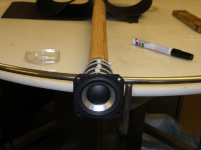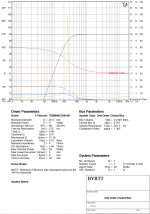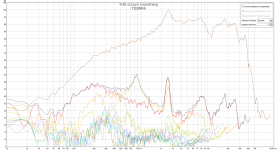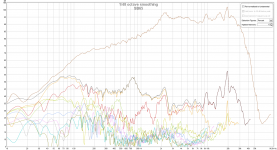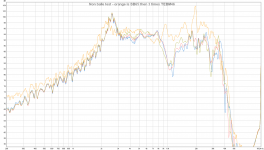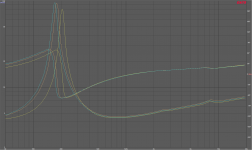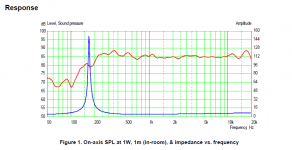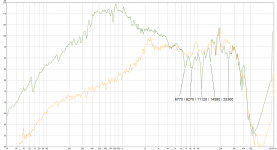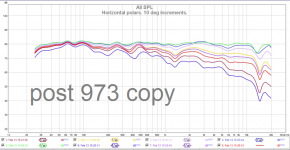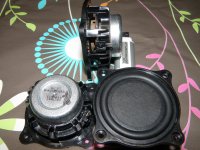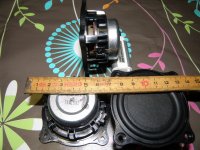For future test paring full ranger to a cheap 2 inch PH-4528 horn makes me think to have best HF integration size of TEBM46C20N-4B/SB65WBAC25 is the better ones to get some success. Will in a week or two share real data how these two compete each other, preliminary i tip to TEBM46 side because BMR is supposed to have better power response the higher the frequency meaning less EQ boost in HF where some amplifiers and DAC begin show there HD, and also because in all links below for SB65 it seems clear to have a third harmonics distortion profile, but lets see later how TEBM46 perform. TEBM46 rubber surround diameter is same as SB65 so they may very well be used to replace each other.
As seen in picture yesterday evening did hang TEBM onto horn with gaffa tape and foam sealing and listening to it actual made me stay up til next morning, it was new and positive subjective experience.
Byrtt,
It would be interesting to see the distortion of that driver when the signal level is higher. The Spec sheet lists X mech at 4mm (8mm p-p) suggesting that linear x max is lower than that, it is more sensitive than the SB65 but maybe cannot produce the same level of clean output if that is important. Maybe another stick test to compare?
fluid,
Good catch there ha ha myself had it read as Xmax but sure i put both devices on the stick : ) test and run them once again so we can compare, that said not sure it need much linear travel stroke because as seen in WinspeakerZ when feeded 20 watt and we real world high-pass filter it in 400-600Hz area it never get even close to 1mm point. Exited myself to see data performance, it has very high mechanical Q which i read a designer praise as good for mids and Overkill Audio praise settling time in general for BMR devices.
Good catch there ha ha myself had it read as Xmax but sure i put both devices on the stick : ) test and run them once again so we can compare, that said not sure it need much linear travel stroke because as seen in WinspeakerZ when feeded 20 watt and we real world high-pass filter it in 400-600Hz area it never get even close to 1mm point. Exited myself to see data performance, it has very high mechanical Q which i read a designer praise as good for mids and Overkill Audio praise settling time in general for BMR devices.
Attachments
Last edited:
fluid,
Good catch there ha ha myself had it read as Xmax but sure i put both devices on the stick : ) test and run them once again so we can compare, that said not sure it need much linear travel stroke because as seen in WinspeakerZ when feeded 20 watt and we real world high-pass filter it in 400-600Hz area it never get even close to 1mm point. Exited myself to see data performance, it has very high mechanical Q which i read a designer praise as good for mids and Overkill Audio praise settling time in general for BMR devices.
Good point I had forgotten that these small drivers tend to be thermally limited more so than x-max limited. Look forward to seeing the comparison graphs.
Erin has tested the TEBM35C10 in case anyone is interested in using it, it's an interesting 2" driver.
Thanks link it looks very good there and mayby because diameter so small will perform well in HF horn XT1464 that Bushmeister used in his build, unfortunate can't find it inside EU yet.
TEBM46C20N-4B measurements.
First is 3 devices measured with DATS device.
Second is 3 devices FR verse one SB65 mounted on a stick (non baffle).
Third is SB65 mounted on a stick (non baffle), SPL meter say 90dB at 30cm with pink noise and 75dB with 400Hz sinus where terminals say 2,51V AC.
Fourth is TEBM46 mounted on a stick (non baffle), SPL meter say 90dB at 30cm with pink noise and 73dB with 400Hz sinus where terminals say 1,62V AC.
Bit exiting how they look later on a baffle or in a horn because that minus 10-12dB hole evolved around 11kHz is beautifull smooth in datasheet.
Fs is some spread around but maybe RS Components is responsible for some of that in they ship them from UK in mail envelope without any box protection, so in one of them there was a fingerprint in membrane therefor they shipped me a new one (still in a mail envelope ) and that's the reason there is three measured.
) and that's the reason there is three measured.
First is 3 devices measured with DATS device.
Second is 3 devices FR verse one SB65 mounted on a stick (non baffle).
Third is SB65 mounted on a stick (non baffle), SPL meter say 90dB at 30cm with pink noise and 75dB with 400Hz sinus where terminals say 2,51V AC.
Fourth is TEBM46 mounted on a stick (non baffle), SPL meter say 90dB at 30cm with pink noise and 73dB with 400Hz sinus where terminals say 1,62V AC.
Bit exiting how they look later on a baffle or in a horn because that minus 10-12dB hole evolved around 11kHz is beautifull smooth in datasheet.
Fs is some spread around but maybe RS Components is responsible for some of that in they ship them from UK in mail envelope without any box protection, so in one of them there was a fingerprint in membrane therefor they shipped me a new one (still in a mail envelope
Attachments
Last edited:
Looks good so far Byrtt, distortion is similar to the SB65 in general with less voltage being needed due to the extra sensitivity.
Seems a bit strange that there is that hole in the frequency response but the shape of it would be easy to EQ flat again depending on the reason for the dip of course.
Look forward to see how it performs in a horn.
Seems a bit strange that there is that hole in the frequency response but the shape of it would be easy to EQ flat again depending on the reason for the dip of course.
Look forward to see how it performs in a horn.
Year Distortion and sensitivity is fine compared SB65 but that FR hole for three units is a bit of fraud compared to beautiful datasheet, maybe got too used to Dayton or SS datasheets. They write response is in room so ha ha it was positioned exactly so that hole was filled by some strategic guided room reflections, also not to speak about that pretty impedance. Maybe it can be EQ'ed as direct radiator but had a quick test in horn for both SB65 and TEBM46 and there is a high Q such-out in same area that will give trouble unless i can fiddle it away with some round-over and/or smart adapter/sealing as Bushmeister did, more measurements for horns in a day or two.
Attachments
Last edited:
They write response is in room so ha ha it was positioned exactly so that hole was filled by some strategic guided room reflections, also not to speak about that pretty impedance.
Very much like them quoting x-mech and not listing x-max. Fudging the datasheet seems a waste of time to me as it will only lead to disappointed customers.
Maybe it can be EQ'ed as direct radiator but had a quick test in horn for both SB65 and TEBM46 and there is a high Q such-out in same area that will give trouble unless i can fiddle it away with some round-over and/or smart adapter/sealing as Bushmeister did, more measurements for horns in a day or two.
Look forward to seeing the results. Really high Q dips are often not audible but look terrible when measured. Could always test with the Frequency dependant window to see what is likely to be heard.
I plan to try and make an adapter like xrk but by using different thicknesses of MDF. I have some router bits with different degrees of chamfer, 11.25, 22.5, 30 and 45 degrees. I tested with a CAD drawing and it looks like it could create a nice profile.
...Look forward to seeing the results. Really high Q dips are often not audible but look terrible when measured. Could always test with the Frequency dependant window to see what is likely to be heard.
I plan to try and make an adapter like xrk but by using different thicknesses of MDF. I have some router bits with different degrees of chamfer, 11.25, 22.5, 30 and 45 degrees. I tested with a CAD drawing and it looks like it could create a nice profile.
Here is preliminary when SB65 are really primitively thrown onto horn with gaffa tape and foam gasket, five null modes that isn't there as direct radiator and the worst of them is just where TEBM46 needs EQ boost. There is still hope to play with smoother ways adapting driver to horn and kill some of it but probably the 11kHz one will continue exist more or less and therefor think SB65 will beat TEBM46 because can't correct it when horn mounted it sits in a null, think even FDW will show problem based on preliminary test.
Attachments
Here is preliminary when SB65 are really primitively thrown onto horn with gaffa tape and foam gasket, five null modes that isn't there as direct radiator and the worst of them is just where TEBM46 needs EQ boost. There is still hope to play with smoother ways adapting driver to horn and kill some of it but probably the 11kHz one will continue exist more or less and therefor think SB65 will beat TEBM46 because can't correct it when horn mounted it sits in a null, think even FDW will show problem based on preliminary test.
Is the 11khz null present in the off-axis measurements also?
Nice work Byrtt. For the TEBM measurements on baffle, is there a thick lip or discontinuity at edge of driver bezel to baffle or flush mounted? 11kHz corresponds to a 1.55cm half wave distance from cone center to some discontinuity - perhaps raised or sunken surround that causes a reflection cancellation. Is there anything corresponding to 1.55cm?
Is the 11khz null present in the off-axis measurements also?
You right i should check that but in my mind based Bushmeisters XT1464 below figure its still there off axis also because preliminary both TEBM46 and SB65 show a null where former of course is huge.
Nice work Byrtt. For the TEBM measurements on baffle, is there a thick lip or discontinuity at edge of driver bezel to baffle or flush mounted? 11kHz corresponds to a 1.55cm half wave distance from cone center to some discontinuity - perhaps raised or sunken surround that causes a reflection cancellation. Is there anything corresponding to 1.55cm?
Thanks helping xrk971 you probably much wiser than me here, admit test was done on a stick with no baffle, but SB65 works fine only having itself as baffle from 2kHz and all the way up so can't see logic why baffle will help TEBM46 other than below about 2kHz area, and also preliminary test in horn show TEBM46 to have this huge dip around 11kHz which is not to see at all into datasheet, could rear waves cancel 11kHz area so it needs to be closed at backside I don't think so. Attach analog old fashion 3d below to analyze : )
Attachments
Here is preliminary when SB65 are really primitively thrown onto horn with gaffa tape and foam gasket, five null modes that isn't there as direct radiator and the worst of them is just where TEBM46 needs EQ boost. There is still hope to play with smoother ways adapting driver to horn and kill some of it but probably the 11kHz one will continue exist more or less and therefor think SB65 will beat TEBM46 because can't correct it when horn mounted it sits in a null, think even FDW will show problem based on preliminary test.
I don't think it is so bad. There is very little smoothing on that graph so it will show all the little lumps and bumps. Do a quick REW auto EQ to get the overall trend flatter, smooth the graph a little and see what you get. The nulls will still be there but the graph will be prettier
In the long term a smooth transition from driver to horn will make it better. Bushmeister had some nulls too at the start.
Thanks link it looks very good there and mayby because diameter so small will perform well in HF horn XT1464 that Bushmeister used in his build, unfortunate can't find it inside EU yet.
Thomann.de has them
https://www.thomann.de/nl/eighteensound_xt_1464.htm?glp=1&gclid=CjwKEAiAn7HEBRDHwNqitoWqsQcSJAADWmI2dbzpBJ9ZWmCArwGz0pwauLpNWG97l9fm7jwWZxi6pxoChz3w_wcB
Thanks link
After reading though the whole thing I’d like to ask the people that build or heard these: how much of a difference is there compared to a “big” synergy horn that covers to about 300~400Hz horn loading? I really like the look of the Davone Ray posted way back here and I think it would make for a very nice enclosure for a small synergy horn.
- Home
- Loudspeakers
- Multi-Way
- A Bookshelf Multi-Way Point-Source Horn
